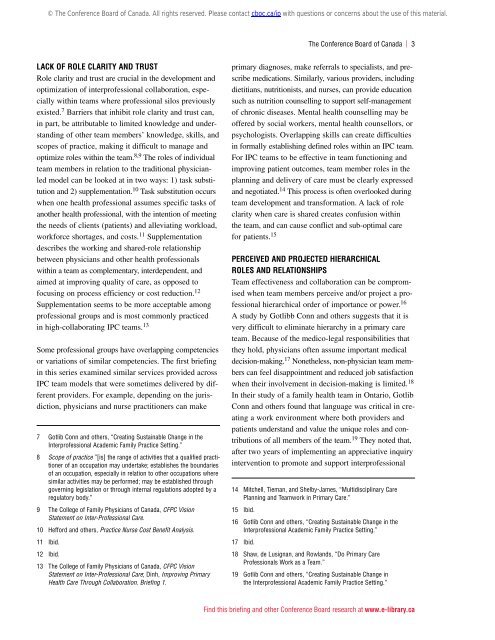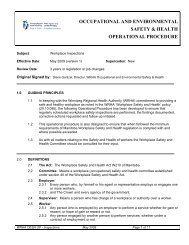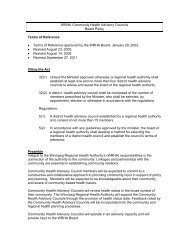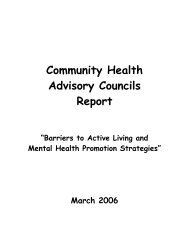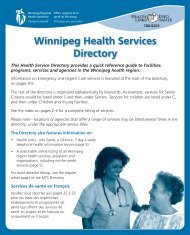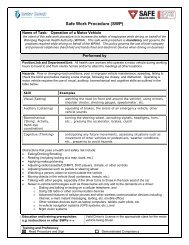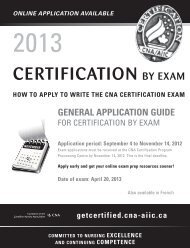Improving Primary Health Care Through Collaboration: Briefing 2 ...
Improving Primary Health Care Through Collaboration: Briefing 2 ...
Improving Primary Health Care Through Collaboration: Briefing 2 ...
- No tags were found...
Create successful ePaper yourself
Turn your PDF publications into a flip-book with our unique Google optimized e-Paper software.
© The Conference Board of Canada. All rights reserved. Please contact cboc.ca/ip with questions or concerns about the use of this material.The Conference Board of Canada | 3Lack of Role Clarity and TrustRole clarity and trust are crucial in the development andoptimization of interprofessional collaboration, especiallywithin teams where professional silos previouslyexisted. 7 Barriers that inhibit role clarity and trust can,in part, be attributable to limited knowledge and understandingof other team members’ knowledge, skills, andscopes of practice, making it difficult to manage andoptimize roles within the team. 8,9 The roles of individualteam members in relation to the traditional physicianledmodel can be looked at in two ways: 1) task substitutionand 2) supplementation. 10 Task substitution occurswhen one health professional assumes specific tasks ofanother health professional, with the intention of meetingthe needs of clients (patients) and alleviating workload,workforce shortages, and costs. 11 Supplementationdescribes the working and shared-role relationshipbetween physicians and other health professionalswithin a team as complementary, interdependent, andaimed at improving quality of care, as opposed tofocusing on process efficiency or cost reduction. 12Supplementation seems to be more acceptable amongprofessional groups and is most commonly practicedin high-collaborating IPC teams. 13Some professional groups have overlapping competenciesor variations of similar competencies. The first briefingin this series examined similar services provided acrossIPC team models that were sometimes delivered by differentproviders. For example, depending on the jurisdiction,physicians and nurse practitioners can make7 Gotlib Conn and others, “Creating Sustainable Change in theInterprofessional Academic Family Practice Setting.”8 Scope of practice ”[is] the range of activities that a qualified practitionerof an occupation may undertake; establishes the boundariesof an occupation, especially in relation to other occupations wheresimilar activities may be performed; may be established throughgoverning legislation or through internal regulations adopted by aregulatory body.”9 The College of Family Physicians of Canada, CFPC VisionStatement on Inter-Professional <strong>Care</strong>.10 Hefford and others, Practice Nurse Cost Benefit Analysis.11 Ibid.12 Ibid.13 The College of Family Physicians of Canada, CFPC VisionStatement on Inter-Professional <strong>Care</strong>; Dinh, <strong>Improving</strong> <strong>Primary</strong><strong>Health</strong> <strong>Care</strong> <strong>Through</strong> <strong>Collaboration</strong>. <strong>Briefing</strong> 1.primary diagnoses, make referrals to specialists, and prescribemedications. Similarly, various providers, includingdietitians, nutritionists, and nurses, can provide educationsuch as nutrition counselling to support self-managementof chronic diseases. Mental health counselling may beoffered by social workers, mental health counsellors, orpsychologists. Overlapping skills can create difficultiesin formally establishing defined roles within an IPC team.For IPC teams to be effective in team functioning andimproving patient outcomes, team member roles in theplanning and delivery of care must be clearly expressedand negotiated. 14 This process is often overlooked duringteam development and transformation. A lack of roleclarity when care is shared creates confusion withinthe team, and can cause conflict and sub-optimal carefor patients. 15Perceived and Projected HierarchicalRoles and RelationshipsTeam effectiveness and collaboration can be compromisedwhen team members perceive and/or project a professionalhierarchical order of importance or power. 16A study by Gotlibb Conn and others suggests that it isvery difficult to eliminate hierarchy in a primary careteam. Because of the medico-legal responsibilities thatthey hold, physicians often assume important medicaldecision-making. 17 Nonetheless, non-physician team memberscan feel disappointment and reduced job satisfactionwhen their involvement in decision-making is limited. 18In their study of a family health team in Ontario, GotlibConn and others found that language was critical in creatinga work environment where both providers andpatients understand and value the unique roles and contributionsof all members of the team. 19 They noted that,after two years of implementing an appreciative inquiryintervention to promote and support interprofessional14 Mitchell, Tieman, and Shelby-James, “Multidisciplinary <strong>Care</strong>Planning and Teamwork in <strong>Primary</strong> <strong>Care</strong>.”15 Ibid.16 Gotlib Conn and others, “Creating Sustainable Change in theInterprofessional Academic Family Practice Setting.”17 Ibid.18 Shaw, de Lusignan, and Rowlands, “Do <strong>Primary</strong> <strong>Care</strong>Professionals Work as a Team.”19 Gotlib Conn and others, “Creating Sustainable Change inthe Interprofessional Academic Family Practice Setting.”Find this briefing and other Conference Board research at www.e-library.ca


